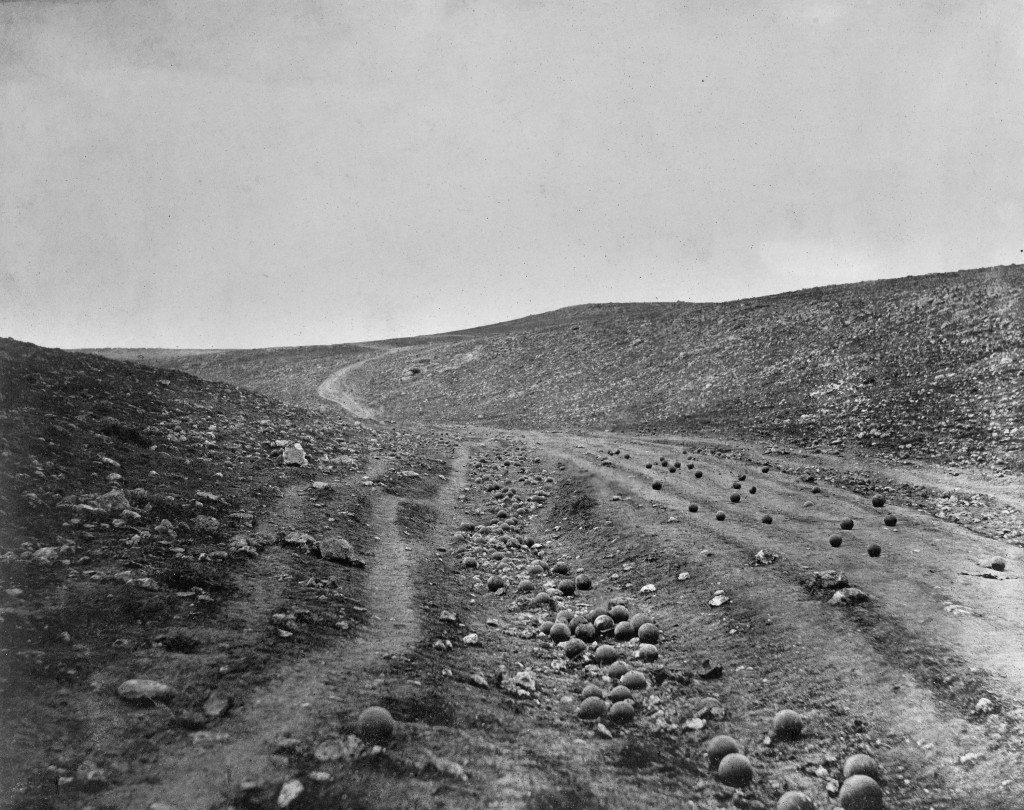Outside of the Frame
Photographers pull an image from the river of time. The result is photograph of one instant and one point of view from a 360-degree world. The skill of the photographer is knowing which moment and angle is the right one to make the image. Because photography has the uncanny ability to render subjects so accurately, people believe it represents reality. The viewer can be lulled into thinking that one moment represents an entire event or scene.
One of the earliest examples of thinking a photo represents reality is an 1855 photograph titled “Valley of the Shadow of Death” by British photographer Roger Fenton. Fenton had been assigned to make a photograph of the Crimean War, but in the Victorian era, photographers did not show the dead and injured. Fenton’s well-known photograph shows a road littered with cannonballs that represent the human casualties. The photo is a powerful depiction of the intense shelling the British soldiers were experiencing in the area they named the Valley of the Shadow of Death in their letters home. The problem with the reality is there is another photograph. In the second photo Fenton made there are no cannonballs on the road, which gives rise to the question, “What happened outside the frame?”

DIGITAL IMAGE COURTESY OF THE GETTY’S OPEN CONTENT PROGRAM
“Valley of the Shadow of Death” 1855 photo by Robert Fenton.
The current thinking is that Fenton deliberately moved all the cannonballs, and some viewers think it was specifically to deceive. Maybe that was his intent, but more than likely, Fenton was compressing all his emotions of what he saw in the war and conveying the true horror of it to the British public back home. We will never know because we only have what is shown inside his frame. We do not know the rest of the story outside of the frame.
The same is true of art. Frames are limiters of the “rest of the story” that lies invisible outside the edges. What is the inspiration of the piece? Did the artist base it on an experience, a relationship, an event in history? From a world of possibilities, why did the artist make this one image to share?
As the viewer, how can we ever know about the story outside the frame? Books have been written about famous artists, their techniques, their stories outside the fame. At exhibitions of a current artist’s work, we could attend a gallery talk given by the artist. In Peoria, First Friday studio tours give the public the opportunity to talk firsthand with the artists. The opening weekend of the annual Sculpture Walk Peoria has the sculptors on hand to meet the public and talk about their inspiration and process.
Sometimes, though, we are left with the mystery of a piece and as viewers it is up to us to fill in the meaning based on our own experiences and memories. At those times, there is a convergence of the artist’s expression inside the frame meeting the experiences and emotions the viewers brings to a piece. That is the beauty of art. The appreciation of what is inside the frame is made meaningful with each viewer’s own personal story standing outside the frame.

Recent Comments